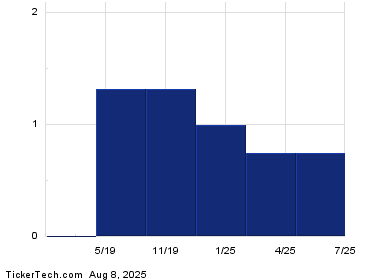Understanding Millicom International Cellular SA’s Dividend Performance
Investing in dividends can provide significant benefits in the stock market, and one company that stands out is Millicom International Cellular SA (Ticker: TIGO). Recently, TIGO shares were showing a yield exceeding 7% based on its quarterly dividend, which has been annualized to $3 per share. On the trading day, shares were moving at approximately $42.02.
The Importance of Dividends
For investors, dividends are a crucial factor to consider when selecting stocks. Historically, dividends have constituted a substantial portion of overall returns in the stock market. For instance, if you had invested in the iShares Russell 3000 ETF (IWV) on May 31, 2000, paying $78.27 per share, you might have been surprised by the value twelve years later. On May 31, 2012, the share price had dropped to $77.79, reflecting a decline of just 0.6%. However, over that same period, the dividends received totaled $10.77 per share. This means that your total return, including dividends, would significantly improve to about 13.15%.
In comparison, maintaining a yield above 7% can be particularly attractive for investors, especially if that yield is sustainable.
Analyzing Millicom International Cellular SA
Millicom International Cellular SA is a significant player in the telecommunications market, classified among the Russell 3000, which consists of some of the largest companies traded in the U.S. stock markets. This status allows it to gain attention and confidence from investors.
The Dividend History of TIGO
To determine the sustainability of TIGO’s latest dividend payout, investors should consider its historical performance. The company’s dividend history can shed light on whether the recent dividend is likely to be replicated in the future. A closer look at the historical chart for TIGO can provide insights into trends and fluctuations in dividend payouts over time.
Factors Influencing Dividend Payments
Dividends are influenced by a variety of factors, particularly the profitability and financial health of the company. In the case of Millicom International Cellular SA, understanding its financial stability and revenue-generating capabilities is crucial in evaluating the likelihood of continued dividend payments.
Market Conditions
The broader market conditions and economic landscape also play a significant role in shaping a company’s financial performance. External factors, such as changes in consumer demand, regulatory challenges, and competitive pressures, can directly impact a company’s ability to maintain or increase its dividends.
Company Performance
Evaluating key performance indicators, such as earnings reports and operational metrics, can help investors gauge Millicom’s potential to sustain its dividend yield. It’s essential to examine revenue growth, profit margins, and debt levels to understand the company’s financial flexibility and long-term viability.
Dividend Strategies for Investors
Investors looking to capitalize on dividend-paying stocks often employ various strategies. Here are some key approaches:
Dividend Reinvestment Plans (DRIPs)
Reinvesting dividends allows investors to purchase additional shares with their dividend earnings, compounding their growth over time. This strategy can lead to greater returns, particularly with high-yield stocks like TIGO.
Diversification
It’s wise for investors to diversify their portfolios across different sectors and industries. Diversifying helps mitigate risks associated with holding a single stock or sector, providing a more stable income stream through dividends.
Long-Term Perspective
Investing for the long term can be beneficial, especially in a fluctuating market. Companies with a solid track record of paying dividends are often viewed as stable investments that can weather economic downturns.
Conclusion
In the world of dividend investing, Millicom International Cellular SA presents an intriguing option for investors seeking robust yields. With its current dividend yield above 7%, TIGO exemplifies how dividends can enhance overall investment returns. By understanding the underlying factors that influence dividends and employing smart investment strategies, investors can make well-informed decisions and potentially benefit from the financial advantages of dividend stocks.
